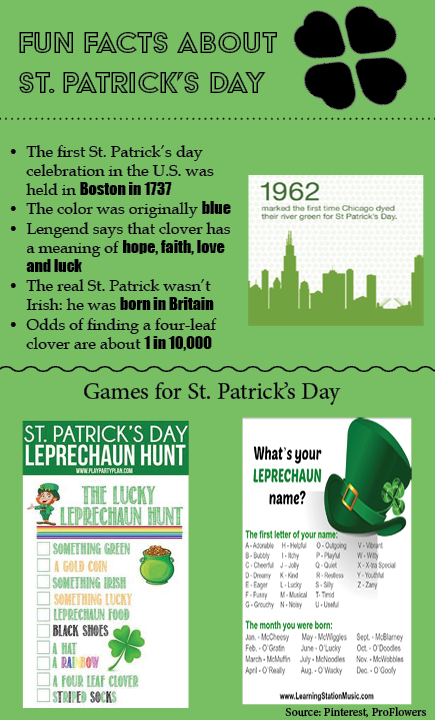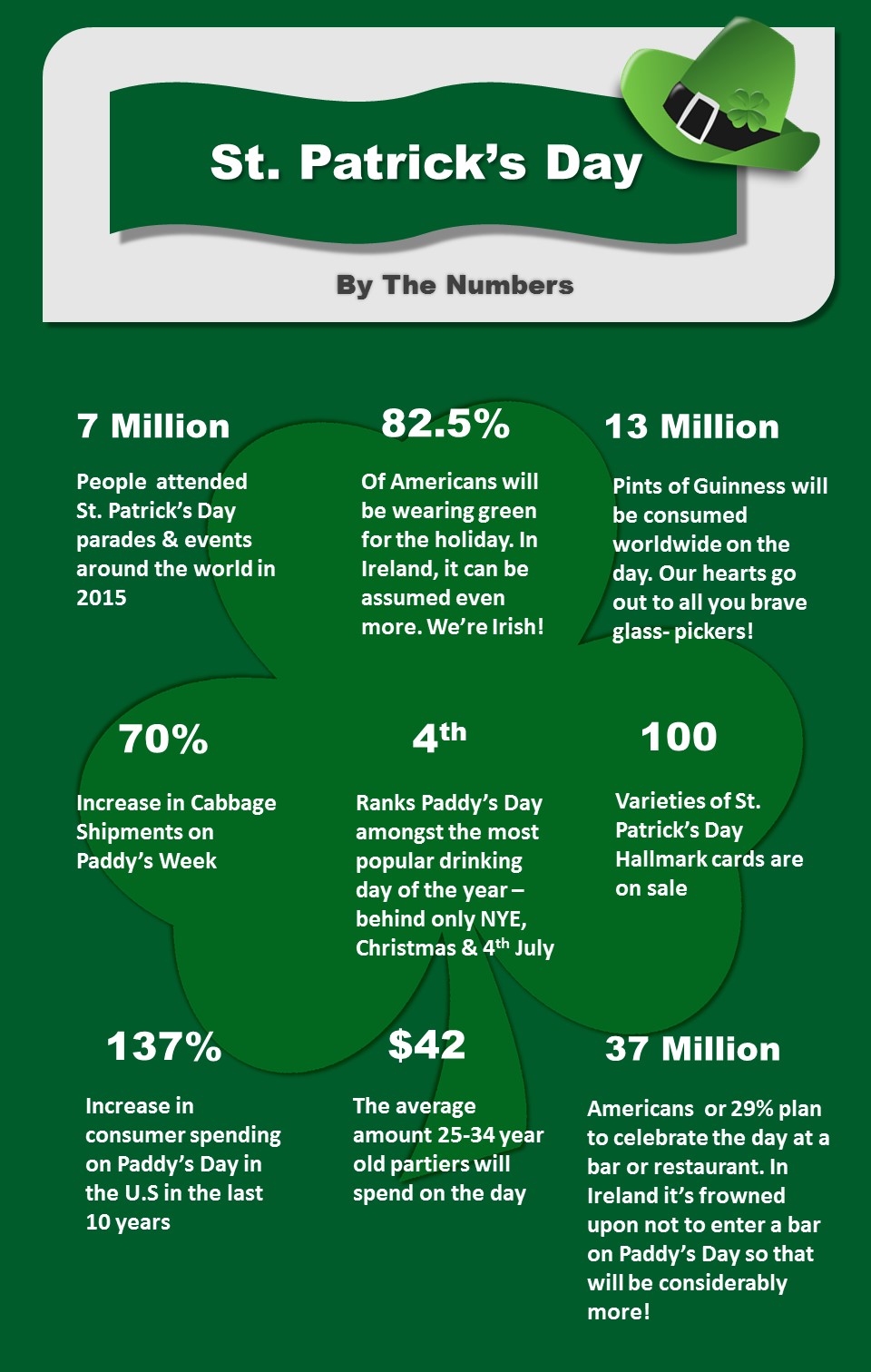Gallery
Photos from events, contest for the best costume, videos from master classes.
 |  |
 |  |
 |  |
 |  |
 |  |
 |  |
53. Where is the home of the biggest St. Patrick’s Day celebration in South America? Answer: Buenos Aires. 54. In Mumbai, what iconic structure is turned green each year to celebrate St. Patrick’s Day? Answer: The Gateway of India. 55. In 2020, the St. Patrick’s Day parade was canceled in NYC for the first time in over 250 years because To determine just how high your St. Paddy's IQ is, we've gathered a list of fascinating trivia questions and St. Patrick's Day facts sure to challenge even the biggest hibernophile. 7. What mythological being is a part of St. Patrick's Day lore and Irish culture? Answer: Leprechauns . 8. Where was the first St. Patrick's Day parade in Ireland held in 1903? Answer: Waterford When you think of St. Patrick’s Day, you might picture parades, green shamrocks, and maybe even a lucky four-leaf clover. But have you ever wondered who St. Patrick really was? Long before he became the face of a global celebration, St. Patrick was a 5th-century missionary who changed the course of Irish history. Patrick's Day is a celebration of Irish culture and heritage, honoring the patron saint of Ireland, St. Patri 23 Facts About St. Patrick's Day - OhMyFacts Discover 23 fascinating facts about St. Patrick's Day, from its origins to modern celebrations, and uncover the rich history behind this festive day. 23. Chicago dyes its river green for St. Patrick’s Day. This annual tradition is a vivid celebration of the holiday in the city. The tradition began in 1962, and it has become an iconic part of the city’s St. Patrick’s Day celebration. St. Patrick’s journey reminds us of how people and cultures can shape a community in unexpected ways. 2. The First St. Patrick’s Day Parade Happened in the U.S. You may assume St. Patrick’s Day parades began in Ireland, but the first recorded parade actually took place in St. Augustine, Florida, in 1601! 2. The First St. Patrick’s Day Parade Was in the U.S. The first recorded St. Patrick’s Day parade didn’t take place in Ireland—it happened in St. Augustine, Florida, in 1601! Later, New York City and Boston became famous for their grand parades, which are still celebrated today. 3. Shamrocks Have a Special Meaning Buenos Aires hosts one of the largest St. Patrick's Day parties in South America. Sydney Opera House is illuminated in green to honor the day. Fun and Quirky Facts. Beyond the well-known traditions, there are many fun and quirky facts about St. Patrick's Day that might surprise you. St. Patrick's Day was a dry holiday in Ireland until the 1970s. The 200 th anniversary of St Patrick’s Day was marked in Sydney Opera House by making it green. 17. The first St Patrick’s Day celebration in the United States was held in Boston in 1737. Dyeing of the Chicago river on Saint Patrick’s day. Image credit – berni0004. 18. On this day, people usually eat corned beef and cabbage, and they From mint chocolate chip cookies to pistachio cake, key lime pie, and shamrock sugar cookies, these St. Patrick’s Day desserts will make your celebration even more magical. Get ready to indulge in the luckiest desserts of the season! 35 Easy St Patrick’s Day Desserts. 1. Matcha Tiramisu This is one of the few St. Patrick’s Day facts that I did know..! The largest St. Patrick’s Day parade in the world takes place in New York City. The parade attracts a staggering two million+ people every year. 4. Ireland’s first parade. The very first St. Patrick’s Day in Ireland was held in County Waterford in 1903. 5. A national holiday St. Patrick’s Day, celebrated on March 17 each year, is known for its parades, shamrocks, and a whole lot of green. It’s a day when people around the world embrace Irish culture — whether they have Irish heritage or not. But behind all the revelry, St. Patrick’s Day has a deep and fascinating history that goes far beyond the modern celebrations. Some of the traditions we associate with 8. Leprechauns are notoriously untrustworthy. Out of all the fairies, leprechauns are by far the sneakiest. They have lots of ways to trick people out of finding out where they have hidden their 3. St. Patrick’s Day was a Dry Holiday An Irish Catholic St. Patrick’s Day celebration. Source: CNN St. Patrick’s Day in modern times is associated with a certain level of debauchery. In the United States, a popular tradition is to have drinks with green food dye added. The worldwide spread of St. Patrick’s Day was partially due to the 1845’s Great Potato Famine that forced more than a million Irish to emigrate. Today, more than 200 countries celebrate it. 10. St. Patrick’s Day Was Once a Dry Holiday. For much of the 20th century, St. Patrick’s Day was considered a strictly religious holiday in Ireland Below you will find a lot of fun St Patricks Day facts for kids. Easy St. Patrick’s Day Facts. This first section is ideal for younger students. They are simple, easy to read, and easy to understand. You can also use them as a starting point and dive a little bit deeper into each fact if you choose. 🍀 Saint Patrick’s Day is on March 17th. Fun facts about St Patrick’s Day and other things to know. Did you know? St Patrick’s Day only became a religious holiday in Ireland in 1903. As a result of St Patrick’s Day being a religious holiday, pubs had to close on St Patrick’s Day until the 1970s, when it was reclassified as a national holiday. Supplies Needed for these St. Patrick’s Day Printables. Some common materials needed for many of these St. Patrick’s Day printables are listed below. Remember, this list is not all-inclusive; specific crafts may require additional items. Printer; Printing paper; Color crayons; Gold coins; Dot markers; 1. St. Patrick’s Day Bingo The first St. Patrick’s Day parade was not in Ireland but in St. Augustine, Florida, in 1601. The modern large-scale St. Patrick’s Day parade tradition started in New York City in 1762. Chicago dyes its river green every St. Patrick’s Day, a tradition that started in 1962.
Articles and news, personal stories, interviews with experts.
Photos from events, contest for the best costume, videos from master classes.
 |  |
 |  |
 |  |
 |  |
 |  |
 |  |